Questions on Healthcare 2022
VerifiedAdded on 2022/10/06
|13
|3530
|19
AI Summary
Contribute Materials
Your contribution can guide someone’s learning journey. Share your
documents today.
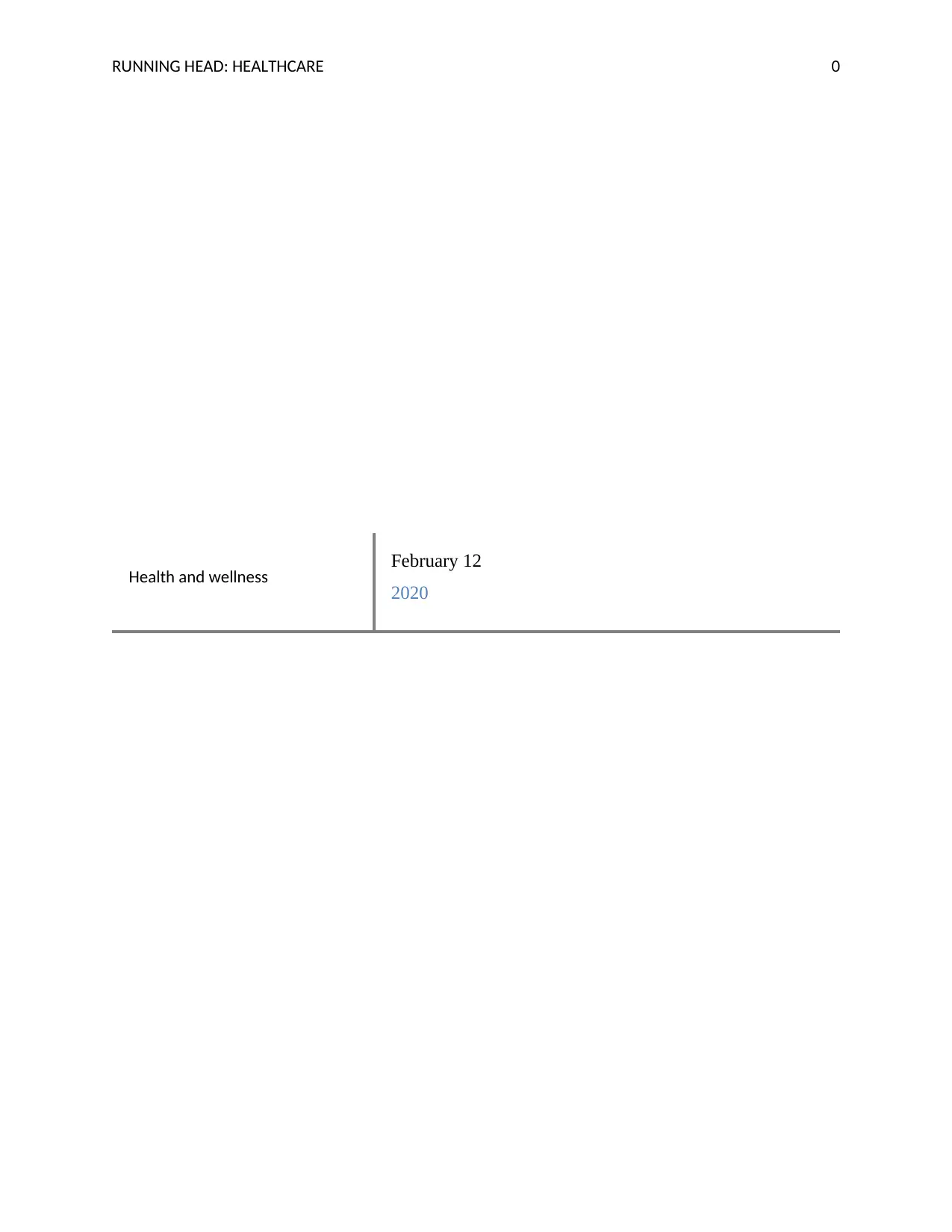
RUNNING HEAD: HEALTHCARE 0
Health and wellness February 12
2020
Health and wellness February 12
2020
Secure Best Marks with AI Grader
Need help grading? Try our AI Grader for instant feedback on your assignments.
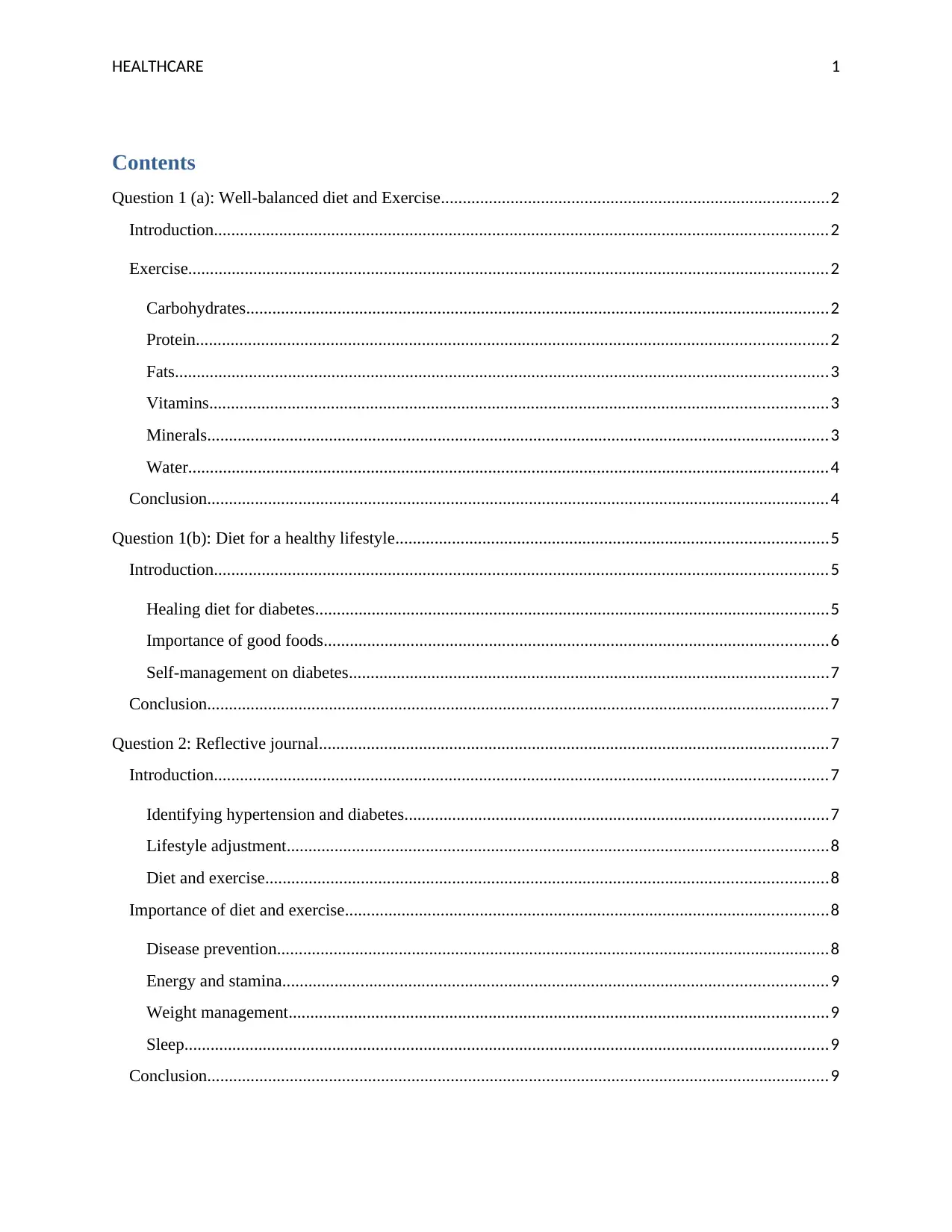
HEALTHCARE 1
Contents
Question 1 (a): Well-balanced diet and Exercise.........................................................................................2
Introduction.............................................................................................................................................2
Exercise...................................................................................................................................................2
Carbohydrates......................................................................................................................................2
Protein.................................................................................................................................................2
Fats......................................................................................................................................................3
Vitamins..............................................................................................................................................3
Minerals...............................................................................................................................................3
Water...................................................................................................................................................4
Conclusion...............................................................................................................................................4
Question 1(b): Diet for a healthy lifestyle...................................................................................................5
Introduction.............................................................................................................................................5
Healing diet for diabetes......................................................................................................................5
Importance of good foods....................................................................................................................6
Self-management on diabetes..............................................................................................................7
Conclusion...............................................................................................................................................7
Question 2: Reflective journal.....................................................................................................................7
Introduction.............................................................................................................................................7
Identifying hypertension and diabetes.................................................................................................7
Lifestyle adjustment............................................................................................................................8
Diet and exercise.................................................................................................................................8
Importance of diet and exercise...............................................................................................................8
Disease prevention...............................................................................................................................8
Energy and stamina.............................................................................................................................9
Weight management............................................................................................................................9
Sleep....................................................................................................................................................9
Conclusion...............................................................................................................................................9
Contents
Question 1 (a): Well-balanced diet and Exercise.........................................................................................2
Introduction.............................................................................................................................................2
Exercise...................................................................................................................................................2
Carbohydrates......................................................................................................................................2
Protein.................................................................................................................................................2
Fats......................................................................................................................................................3
Vitamins..............................................................................................................................................3
Minerals...............................................................................................................................................3
Water...................................................................................................................................................4
Conclusion...............................................................................................................................................4
Question 1(b): Diet for a healthy lifestyle...................................................................................................5
Introduction.............................................................................................................................................5
Healing diet for diabetes......................................................................................................................5
Importance of good foods....................................................................................................................6
Self-management on diabetes..............................................................................................................7
Conclusion...............................................................................................................................................7
Question 2: Reflective journal.....................................................................................................................7
Introduction.............................................................................................................................................7
Identifying hypertension and diabetes.................................................................................................7
Lifestyle adjustment............................................................................................................................8
Diet and exercise.................................................................................................................................8
Importance of diet and exercise...............................................................................................................8
Disease prevention...............................................................................................................................8
Energy and stamina.............................................................................................................................9
Weight management............................................................................................................................9
Sleep....................................................................................................................................................9
Conclusion...............................................................................................................................................9
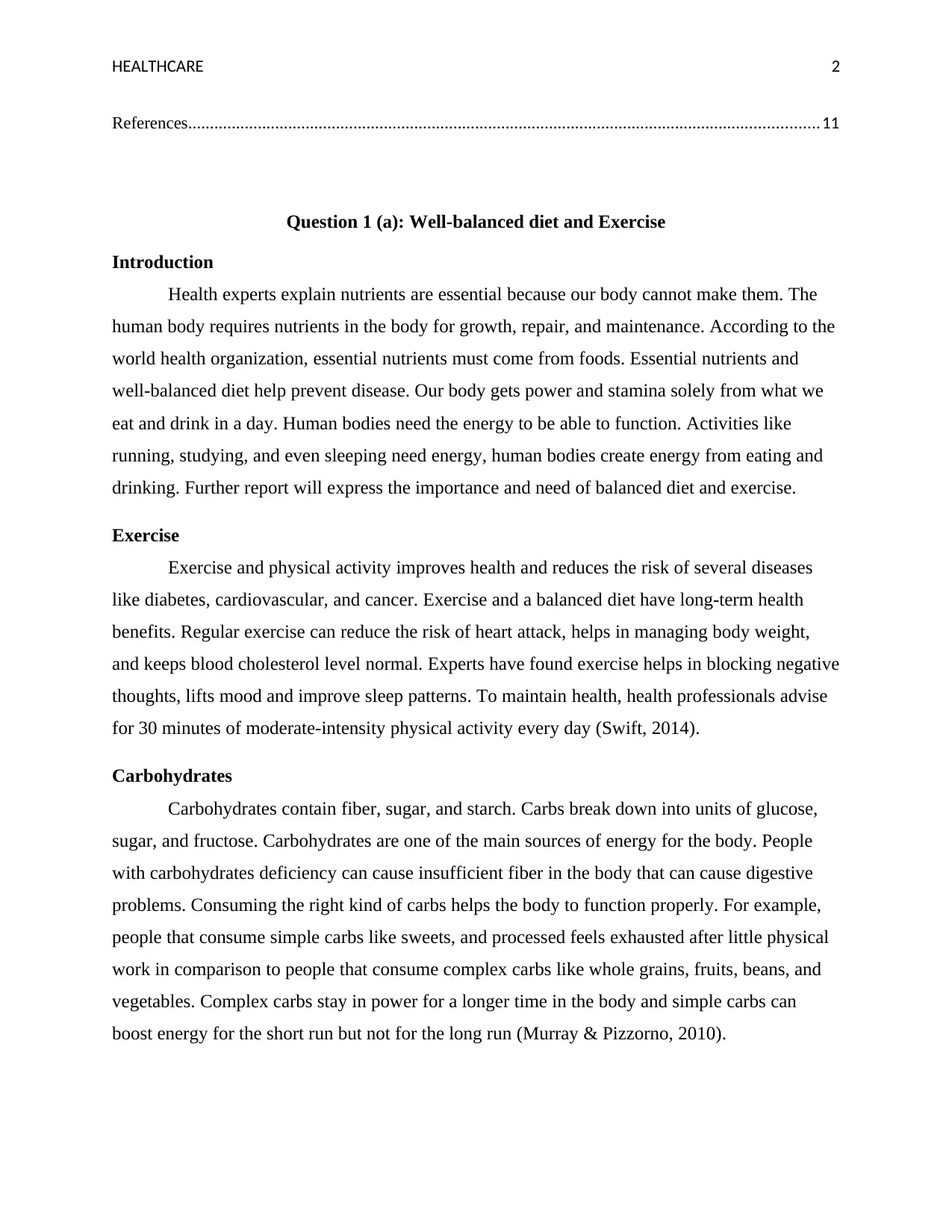
HEALTHCARE 2
References.................................................................................................................................................11
Question 1 (a): Well-balanced diet and Exercise
Introduction
Health experts explain nutrients are essential because our body cannot make them. The
human body requires nutrients in the body for growth, repair, and maintenance. According to the
world health organization, essential nutrients must come from foods. Essential nutrients and
well-balanced diet help prevent disease. Our body gets power and stamina solely from what we
eat and drink in a day. Human bodies need the energy to be able to function. Activities like
running, studying, and even sleeping need energy, human bodies create energy from eating and
drinking. Further report will express the importance and need of balanced diet and exercise.
Exercise
Exercise and physical activity improves health and reduces the risk of several diseases
like diabetes, cardiovascular, and cancer. Exercise and a balanced diet have long-term health
benefits. Regular exercise can reduce the risk of heart attack, helps in managing body weight,
and keeps blood cholesterol level normal. Experts have found exercise helps in blocking negative
thoughts, lifts mood and improve sleep patterns. To maintain health, health professionals advise
for 30 minutes of moderate-intensity physical activity every day (Swift, 2014).
Carbohydrates
Carbohydrates contain fiber, sugar, and starch. Carbs break down into units of glucose,
sugar, and fructose. Carbohydrates are one of the main sources of energy for the body. People
with carbohydrates deficiency can cause insufficient fiber in the body that can cause digestive
problems. Consuming the right kind of carbs helps the body to function properly. For example,
people that consume simple carbs like sweets, and processed feels exhausted after little physical
work in comparison to people that consume complex carbs like whole grains, fruits, beans, and
vegetables. Complex carbs stay in power for a longer time in the body and simple carbs can
boost energy for the short run but not for the long run (Murray & Pizzorno, 2010).
References.................................................................................................................................................11
Question 1 (a): Well-balanced diet and Exercise
Introduction
Health experts explain nutrients are essential because our body cannot make them. The
human body requires nutrients in the body for growth, repair, and maintenance. According to the
world health organization, essential nutrients must come from foods. Essential nutrients and
well-balanced diet help prevent disease. Our body gets power and stamina solely from what we
eat and drink in a day. Human bodies need the energy to be able to function. Activities like
running, studying, and even sleeping need energy, human bodies create energy from eating and
drinking. Further report will express the importance and need of balanced diet and exercise.
Exercise
Exercise and physical activity improves health and reduces the risk of several diseases
like diabetes, cardiovascular, and cancer. Exercise and a balanced diet have long-term health
benefits. Regular exercise can reduce the risk of heart attack, helps in managing body weight,
and keeps blood cholesterol level normal. Experts have found exercise helps in blocking negative
thoughts, lifts mood and improve sleep patterns. To maintain health, health professionals advise
for 30 minutes of moderate-intensity physical activity every day (Swift, 2014).
Carbohydrates
Carbohydrates contain fiber, sugar, and starch. Carbs break down into units of glucose,
sugar, and fructose. Carbohydrates are one of the main sources of energy for the body. People
with carbohydrates deficiency can cause insufficient fiber in the body that can cause digestive
problems. Consuming the right kind of carbs helps the body to function properly. For example,
people that consume simple carbs like sweets, and processed feels exhausted after little physical
work in comparison to people that consume complex carbs like whole grains, fruits, beans, and
vegetables. Complex carbs stay in power for a longer time in the body and simple carbs can
boost energy for the short run but not for the long run (Murray & Pizzorno, 2010).
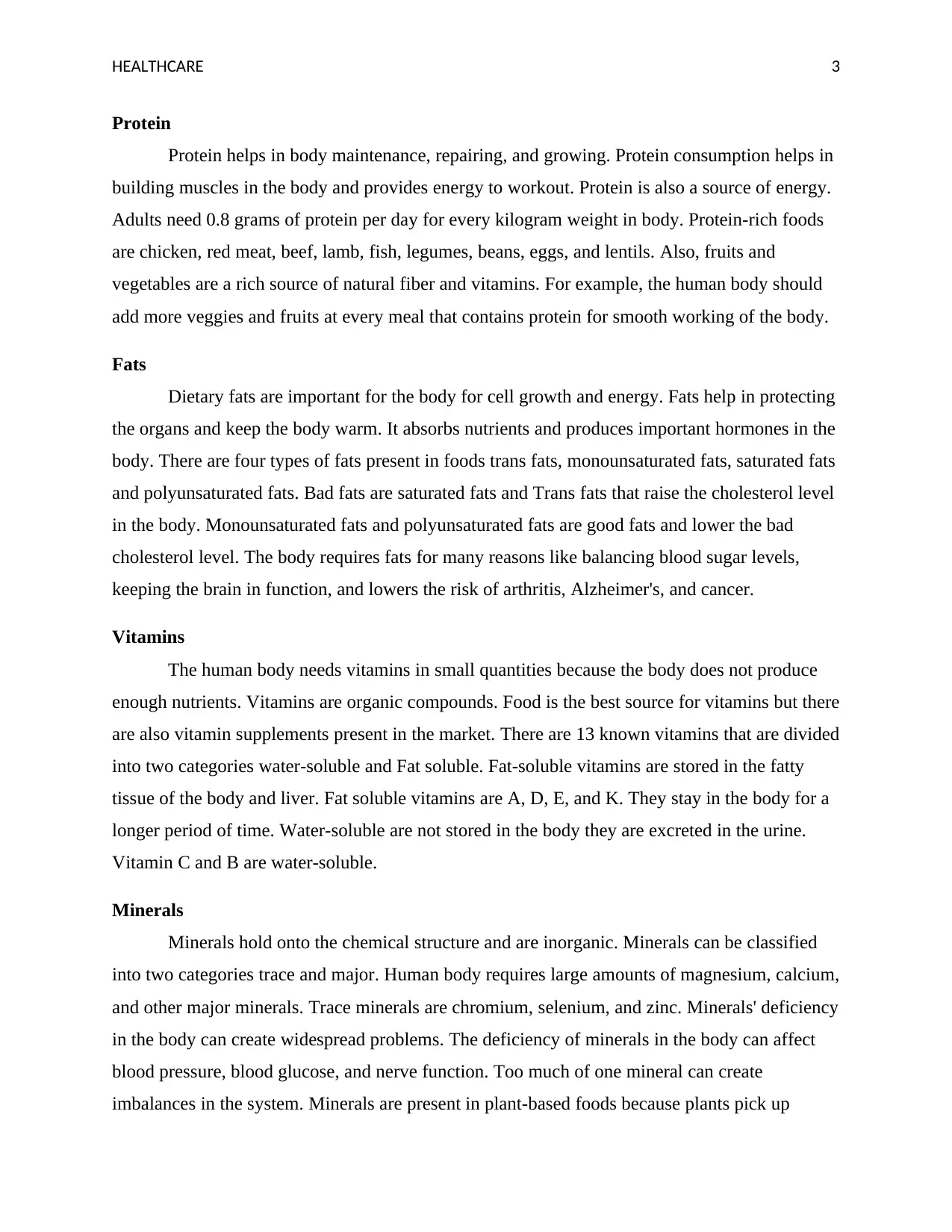
HEALTHCARE 3
Protein
Protein helps in body maintenance, repairing, and growing. Protein consumption helps in
building muscles in the body and provides energy to workout. Protein is also a source of energy.
Adults need 0.8 grams of protein per day for every kilogram weight in body. Protein-rich foods
are chicken, red meat, beef, lamb, fish, legumes, beans, eggs, and lentils. Also, fruits and
vegetables are a rich source of natural fiber and vitamins. For example, the human body should
add more veggies and fruits at every meal that contains protein for smooth working of the body.
Fats
Dietary fats are important for the body for cell growth and energy. Fats help in protecting
the organs and keep the body warm. It absorbs nutrients and produces important hormones in the
body. There are four types of fats present in foods trans fats, monounsaturated fats, saturated fats
and polyunsaturated fats. Bad fats are saturated fats and Trans fats that raise the cholesterol level
in the body. Monounsaturated fats and polyunsaturated fats are good fats and lower the bad
cholesterol level. The body requires fats for many reasons like balancing blood sugar levels,
keeping the brain in function, and lowers the risk of arthritis, Alzheimer's, and cancer.
Vitamins
The human body needs vitamins in small quantities because the body does not produce
enough nutrients. Vitamins are organic compounds. Food is the best source for vitamins but there
are also vitamin supplements present in the market. There are 13 known vitamins that are divided
into two categories water-soluble and Fat soluble. Fat-soluble vitamins are stored in the fatty
tissue of the body and liver. Fat soluble vitamins are A, D, E, and K. They stay in the body for a
longer period of time. Water-soluble are not stored in the body they are excreted in the urine.
Vitamin C and B are water-soluble.
Minerals
Minerals hold onto the chemical structure and are inorganic. Minerals can be classified
into two categories trace and major. Human body requires large amounts of magnesium, calcium,
and other major minerals. Trace minerals are chromium, selenium, and zinc. Minerals' deficiency
in the body can create widespread problems. The deficiency of minerals in the body can affect
blood pressure, blood glucose, and nerve function. Too much of one mineral can create
imbalances in the system. Minerals are present in plant-based foods because plants pick up
Protein
Protein helps in body maintenance, repairing, and growing. Protein consumption helps in
building muscles in the body and provides energy to workout. Protein is also a source of energy.
Adults need 0.8 grams of protein per day for every kilogram weight in body. Protein-rich foods
are chicken, red meat, beef, lamb, fish, legumes, beans, eggs, and lentils. Also, fruits and
vegetables are a rich source of natural fiber and vitamins. For example, the human body should
add more veggies and fruits at every meal that contains protein for smooth working of the body.
Fats
Dietary fats are important for the body for cell growth and energy. Fats help in protecting
the organs and keep the body warm. It absorbs nutrients and produces important hormones in the
body. There are four types of fats present in foods trans fats, monounsaturated fats, saturated fats
and polyunsaturated fats. Bad fats are saturated fats and Trans fats that raise the cholesterol level
in the body. Monounsaturated fats and polyunsaturated fats are good fats and lower the bad
cholesterol level. The body requires fats for many reasons like balancing blood sugar levels,
keeping the brain in function, and lowers the risk of arthritis, Alzheimer's, and cancer.
Vitamins
The human body needs vitamins in small quantities because the body does not produce
enough nutrients. Vitamins are organic compounds. Food is the best source for vitamins but there
are also vitamin supplements present in the market. There are 13 known vitamins that are divided
into two categories water-soluble and Fat soluble. Fat-soluble vitamins are stored in the fatty
tissue of the body and liver. Fat soluble vitamins are A, D, E, and K. They stay in the body for a
longer period of time. Water-soluble are not stored in the body they are excreted in the urine.
Vitamin C and B are water-soluble.
Minerals
Minerals hold onto the chemical structure and are inorganic. Minerals can be classified
into two categories trace and major. Human body requires large amounts of magnesium, calcium,
and other major minerals. Trace minerals are chromium, selenium, and zinc. Minerals' deficiency
in the body can create widespread problems. The deficiency of minerals in the body can affect
blood pressure, blood glucose, and nerve function. Too much of one mineral can create
imbalances in the system. Minerals are present in plant-based foods because plants pick up
Secure Best Marks with AI Grader
Need help grading? Try our AI Grader for instant feedback on your assignments.
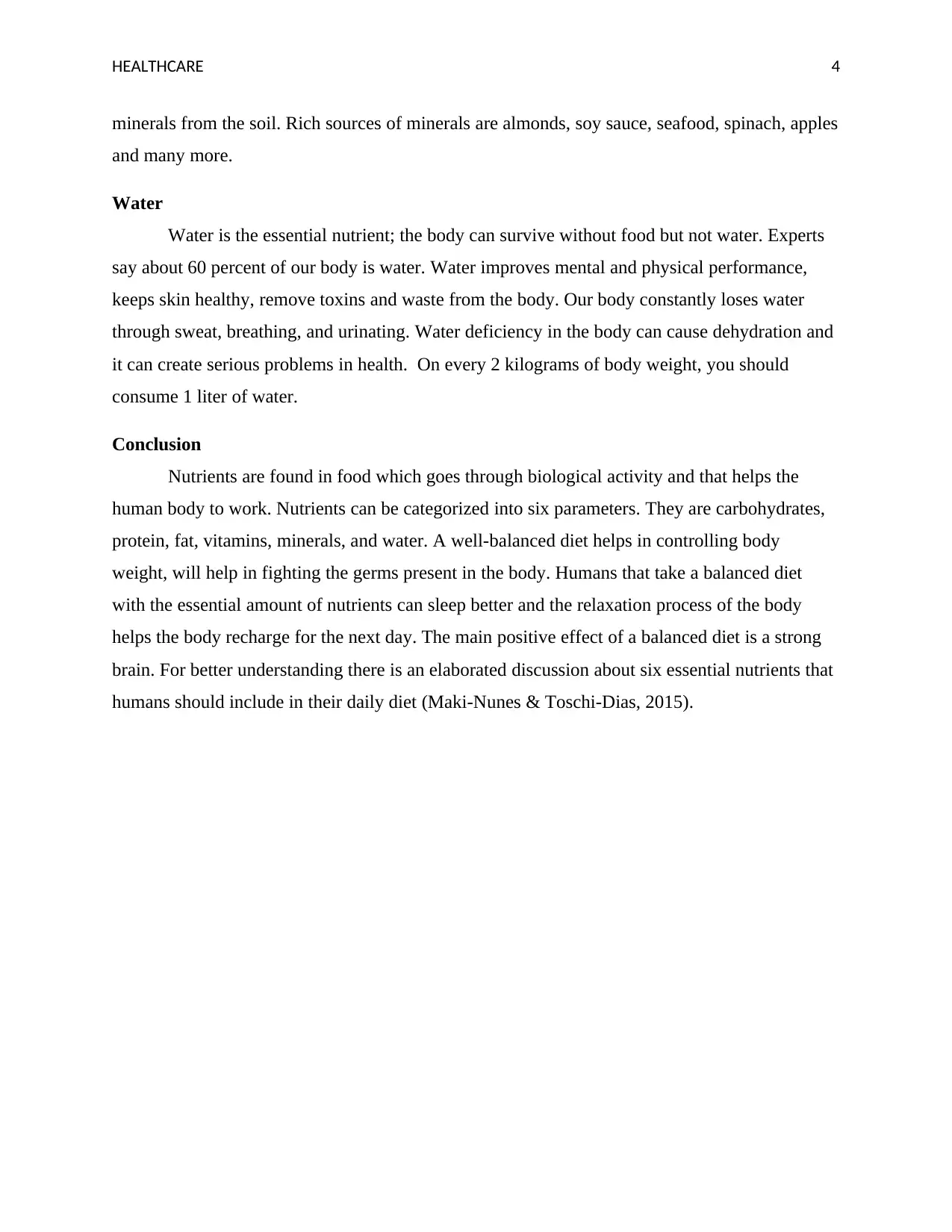
HEALTHCARE 4
minerals from the soil. Rich sources of minerals are almonds, soy sauce, seafood, spinach, apples
and many more.
Water
Water is the essential nutrient; the body can survive without food but not water. Experts
say about 60 percent of our body is water. Water improves mental and physical performance,
keeps skin healthy, remove toxins and waste from the body. Our body constantly loses water
through sweat, breathing, and urinating. Water deficiency in the body can cause dehydration and
it can create serious problems in health. On every 2 kilograms of body weight, you should
consume 1 liter of water.
Conclusion
Nutrients are found in food which goes through biological activity and that helps the
human body to work. Nutrients can be categorized into six parameters. They are carbohydrates,
protein, fat, vitamins, minerals, and water. A well-balanced diet helps in controlling body
weight, will help in fighting the germs present in the body. Humans that take a balanced diet
with the essential amount of nutrients can sleep better and the relaxation process of the body
helps the body recharge for the next day. The main positive effect of a balanced diet is a strong
brain. For better understanding there is an elaborated discussion about six essential nutrients that
humans should include in their daily diet (Maki‐Nunes & Toschi‐Dias, 2015).
minerals from the soil. Rich sources of minerals are almonds, soy sauce, seafood, spinach, apples
and many more.
Water
Water is the essential nutrient; the body can survive without food but not water. Experts
say about 60 percent of our body is water. Water improves mental and physical performance,
keeps skin healthy, remove toxins and waste from the body. Our body constantly loses water
through sweat, breathing, and urinating. Water deficiency in the body can cause dehydration and
it can create serious problems in health. On every 2 kilograms of body weight, you should
consume 1 liter of water.
Conclusion
Nutrients are found in food which goes through biological activity and that helps the
human body to work. Nutrients can be categorized into six parameters. They are carbohydrates,
protein, fat, vitamins, minerals, and water. A well-balanced diet helps in controlling body
weight, will help in fighting the germs present in the body. Humans that take a balanced diet
with the essential amount of nutrients can sleep better and the relaxation process of the body
helps the body recharge for the next day. The main positive effect of a balanced diet is a strong
brain. For better understanding there is an elaborated discussion about six essential nutrients that
humans should include in their daily diet (Maki‐Nunes & Toschi‐Dias, 2015).
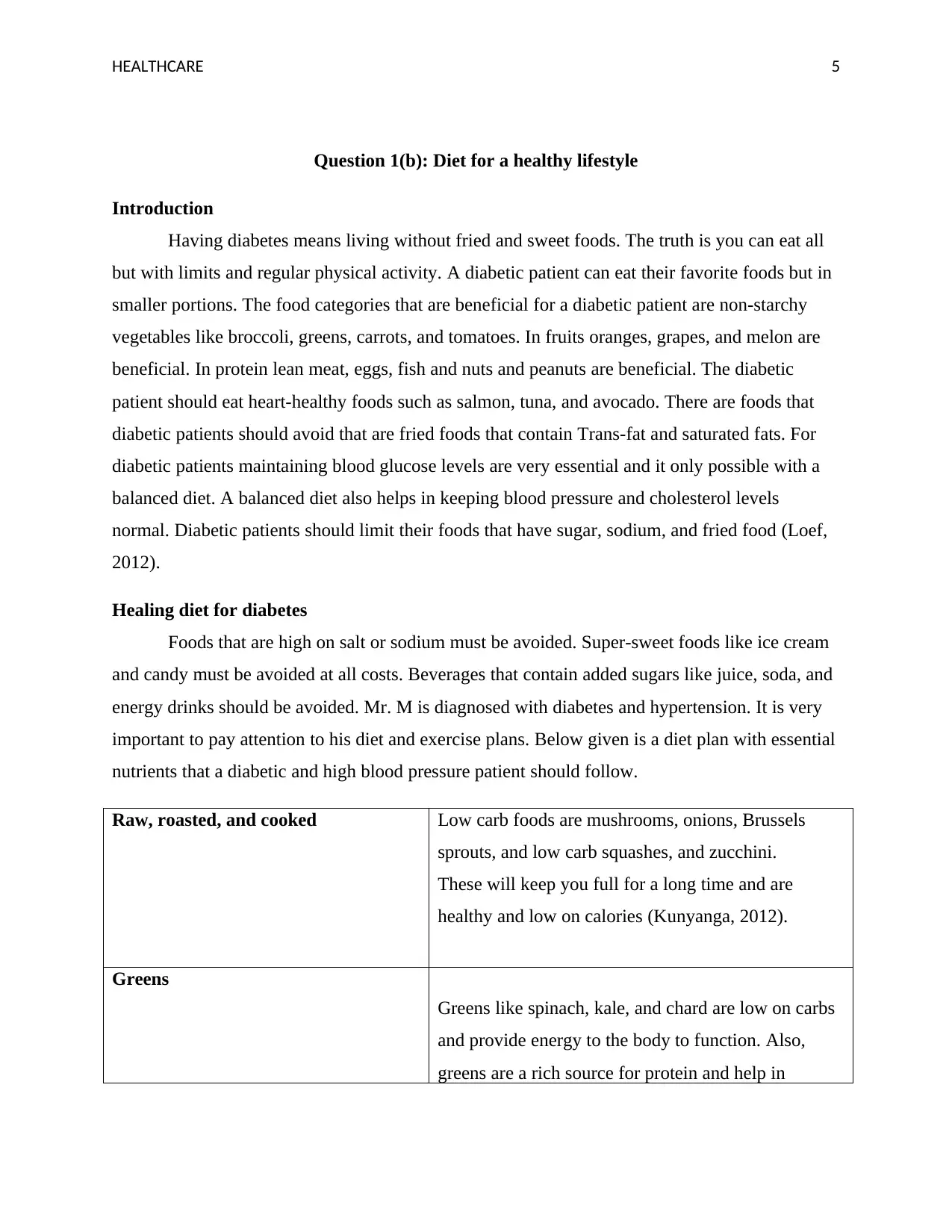
HEALTHCARE 5
Question 1(b): Diet for a healthy lifestyle
Introduction
Having diabetes means living without fried and sweet foods. The truth is you can eat all
but with limits and regular physical activity. A diabetic patient can eat their favorite foods but in
smaller portions. The food categories that are beneficial for a diabetic patient are non-starchy
vegetables like broccoli, greens, carrots, and tomatoes. In fruits oranges, grapes, and melon are
beneficial. In protein lean meat, eggs, fish and nuts and peanuts are beneficial. The diabetic
patient should eat heart-healthy foods such as salmon, tuna, and avocado. There are foods that
diabetic patients should avoid that are fried foods that contain Trans-fat and saturated fats. For
diabetic patients maintaining blood glucose levels are very essential and it only possible with a
balanced diet. A balanced diet also helps in keeping blood pressure and cholesterol levels
normal. Diabetic patients should limit their foods that have sugar, sodium, and fried food (Loef,
2012).
Healing diet for diabetes
Foods that are high on salt or sodium must be avoided. Super-sweet foods like ice cream
and candy must be avoided at all costs. Beverages that contain added sugars like juice, soda, and
energy drinks should be avoided. Mr. M is diagnosed with diabetes and hypertension. It is very
important to pay attention to his diet and exercise plans. Below given is a diet plan with essential
nutrients that a diabetic and high blood pressure patient should follow.
Raw, roasted, and cooked Low carb foods are mushrooms, onions, Brussels
sprouts, and low carb squashes, and zucchini.
These will keep you full for a long time and are
healthy and low on calories (Kunyanga, 2012).
Greens
Greens like spinach, kale, and chard are low on carbs
and provide energy to the body to function. Also,
greens are a rich source for protein and help in
Question 1(b): Diet for a healthy lifestyle
Introduction
Having diabetes means living without fried and sweet foods. The truth is you can eat all
but with limits and regular physical activity. A diabetic patient can eat their favorite foods but in
smaller portions. The food categories that are beneficial for a diabetic patient are non-starchy
vegetables like broccoli, greens, carrots, and tomatoes. In fruits oranges, grapes, and melon are
beneficial. In protein lean meat, eggs, fish and nuts and peanuts are beneficial. The diabetic
patient should eat heart-healthy foods such as salmon, tuna, and avocado. There are foods that
diabetic patients should avoid that are fried foods that contain Trans-fat and saturated fats. For
diabetic patients maintaining blood glucose levels are very essential and it only possible with a
balanced diet. A balanced diet also helps in keeping blood pressure and cholesterol levels
normal. Diabetic patients should limit their foods that have sugar, sodium, and fried food (Loef,
2012).
Healing diet for diabetes
Foods that are high on salt or sodium must be avoided. Super-sweet foods like ice cream
and candy must be avoided at all costs. Beverages that contain added sugars like juice, soda, and
energy drinks should be avoided. Mr. M is diagnosed with diabetes and hypertension. It is very
important to pay attention to his diet and exercise plans. Below given is a diet plan with essential
nutrients that a diabetic and high blood pressure patient should follow.
Raw, roasted, and cooked Low carb foods are mushrooms, onions, Brussels
sprouts, and low carb squashes, and zucchini.
These will keep you full for a long time and are
healthy and low on calories (Kunyanga, 2012).
Greens
Greens like spinach, kale, and chard are low on carbs
and provide energy to the body to function. Also,
greens are a rich source for protein and help in
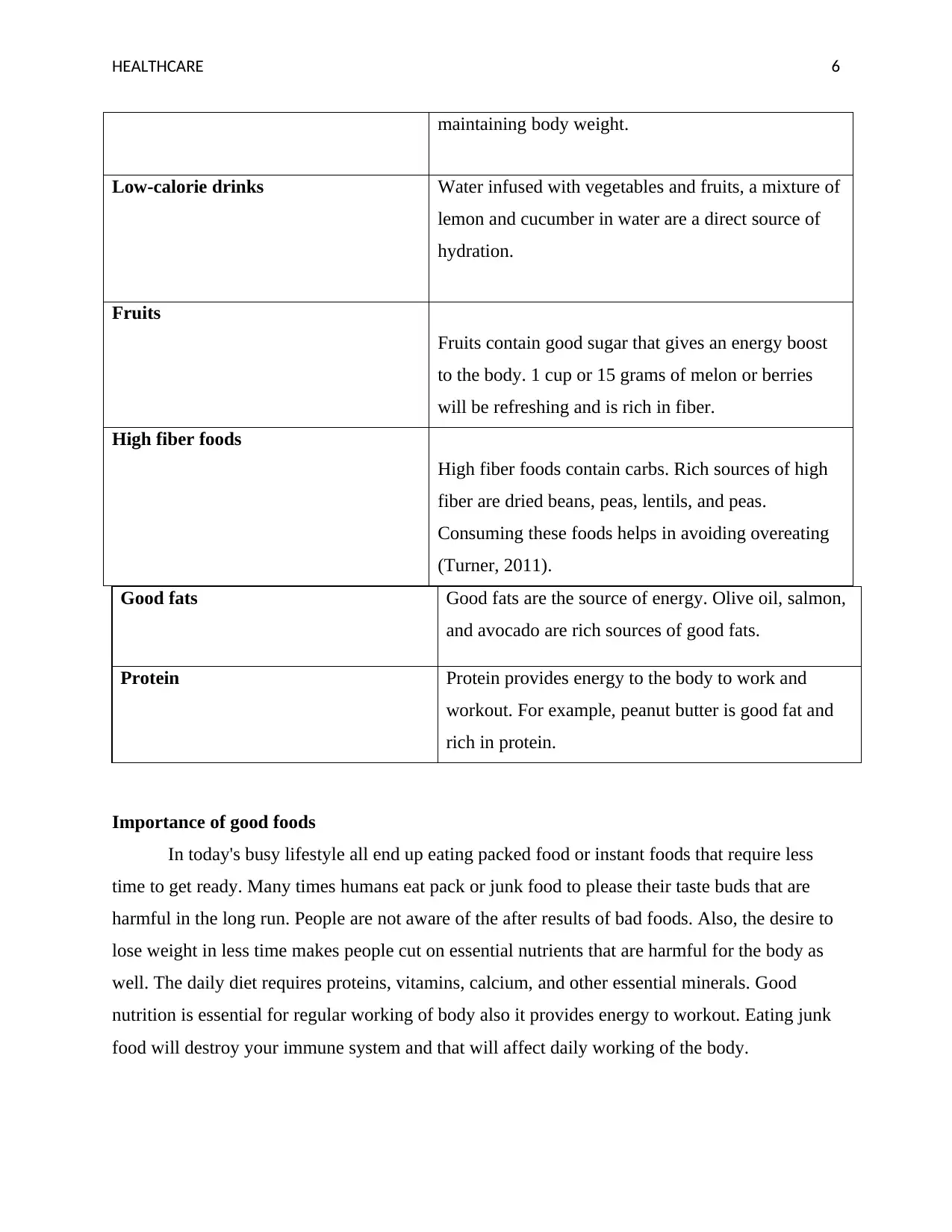
HEALTHCARE 6
maintaining body weight.
Low-calorie drinks Water infused with vegetables and fruits, a mixture of
lemon and cucumber in water are a direct source of
hydration.
Fruits
Fruits contain good sugar that gives an energy boost
to the body. 1 cup or 15 grams of melon or berries
will be refreshing and is rich in fiber.
High fiber foods
High fiber foods contain carbs. Rich sources of high
fiber are dried beans, peas, lentils, and peas.
Consuming these foods helps in avoiding overeating
(Turner, 2011).
Good fats Good fats are the source of energy. Olive oil, salmon,
and avocado are rich sources of good fats.
Protein Protein provides energy to the body to work and
workout. For example, peanut butter is good fat and
rich in protein.
Importance of good foods
In today's busy lifestyle all end up eating packed food or instant foods that require less
time to get ready. Many times humans eat pack or junk food to please their taste buds that are
harmful in the long run. People are not aware of the after results of bad foods. Also, the desire to
lose weight in less time makes people cut on essential nutrients that are harmful for the body as
well. The daily diet requires proteins, vitamins, calcium, and other essential minerals. Good
nutrition is essential for regular working of body also it provides energy to workout. Eating junk
food will destroy your immune system and that will affect daily working of the body.
maintaining body weight.
Low-calorie drinks Water infused with vegetables and fruits, a mixture of
lemon and cucumber in water are a direct source of
hydration.
Fruits
Fruits contain good sugar that gives an energy boost
to the body. 1 cup or 15 grams of melon or berries
will be refreshing and is rich in fiber.
High fiber foods
High fiber foods contain carbs. Rich sources of high
fiber are dried beans, peas, lentils, and peas.
Consuming these foods helps in avoiding overeating
(Turner, 2011).
Good fats Good fats are the source of energy. Olive oil, salmon,
and avocado are rich sources of good fats.
Protein Protein provides energy to the body to work and
workout. For example, peanut butter is good fat and
rich in protein.
Importance of good foods
In today's busy lifestyle all end up eating packed food or instant foods that require less
time to get ready. Many times humans eat pack or junk food to please their taste buds that are
harmful in the long run. People are not aware of the after results of bad foods. Also, the desire to
lose weight in less time makes people cut on essential nutrients that are harmful for the body as
well. The daily diet requires proteins, vitamins, calcium, and other essential minerals. Good
nutrition is essential for regular working of body also it provides energy to workout. Eating junk
food will destroy your immune system and that will affect daily working of the body.
Paraphrase This Document
Need a fresh take? Get an instant paraphrase of this document with our AI Paraphraser
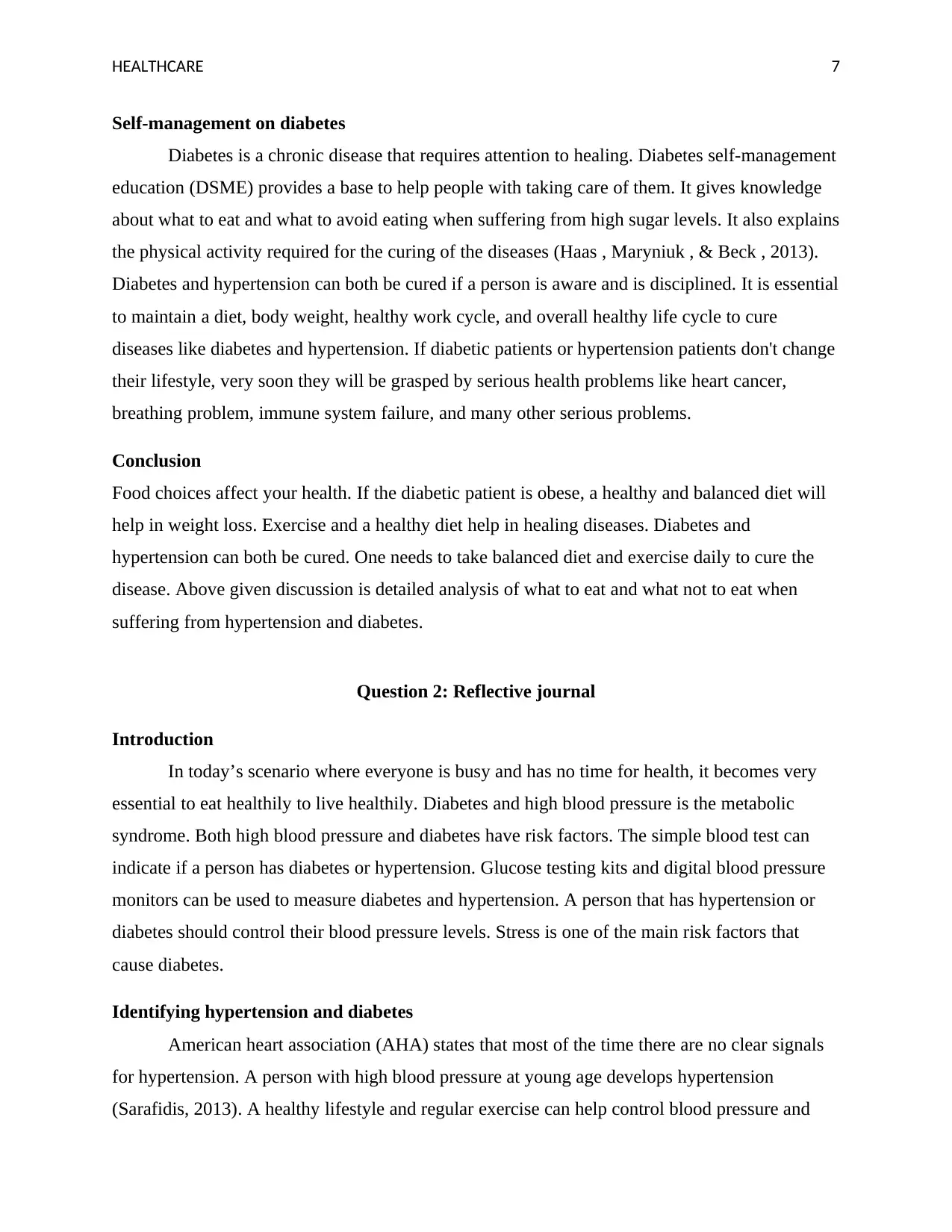
HEALTHCARE 7
Self-management on diabetes
Diabetes is a chronic disease that requires attention to healing. Diabetes self-management
education (DSME) provides a base to help people with taking care of them. It gives knowledge
about what to eat and what to avoid eating when suffering from high sugar levels. It also explains
the physical activity required for the curing of the diseases (Haas , Maryniuk , & Beck , 2013).
Diabetes and hypertension can both be cured if a person is aware and is disciplined. It is essential
to maintain a diet, body weight, healthy work cycle, and overall healthy life cycle to cure
diseases like diabetes and hypertension. If diabetic patients or hypertension patients don't change
their lifestyle, very soon they will be grasped by serious health problems like heart cancer,
breathing problem, immune system failure, and many other serious problems.
Conclusion
Food choices affect your health. If the diabetic patient is obese, a healthy and balanced diet will
help in weight loss. Exercise and a healthy diet help in healing diseases. Diabetes and
hypertension can both be cured. One needs to take balanced diet and exercise daily to cure the
disease. Above given discussion is detailed analysis of what to eat and what not to eat when
suffering from hypertension and diabetes.
Question 2: Reflective journal
Introduction
In today’s scenario where everyone is busy and has no time for health, it becomes very
essential to eat healthily to live healthily. Diabetes and high blood pressure is the metabolic
syndrome. Both high blood pressure and diabetes have risk factors. The simple blood test can
indicate if a person has diabetes or hypertension. Glucose testing kits and digital blood pressure
monitors can be used to measure diabetes and hypertension. A person that has hypertension or
diabetes should control their blood pressure levels. Stress is one of the main risk factors that
cause diabetes.
Identifying hypertension and diabetes
American heart association (AHA) states that most of the time there are no clear signals
for hypertension. A person with high blood pressure at young age develops hypertension
(Sarafidis, 2013). A healthy lifestyle and regular exercise can help control blood pressure and
Self-management on diabetes
Diabetes is a chronic disease that requires attention to healing. Diabetes self-management
education (DSME) provides a base to help people with taking care of them. It gives knowledge
about what to eat and what to avoid eating when suffering from high sugar levels. It also explains
the physical activity required for the curing of the diseases (Haas , Maryniuk , & Beck , 2013).
Diabetes and hypertension can both be cured if a person is aware and is disciplined. It is essential
to maintain a diet, body weight, healthy work cycle, and overall healthy life cycle to cure
diseases like diabetes and hypertension. If diabetic patients or hypertension patients don't change
their lifestyle, very soon they will be grasped by serious health problems like heart cancer,
breathing problem, immune system failure, and many other serious problems.
Conclusion
Food choices affect your health. If the diabetic patient is obese, a healthy and balanced diet will
help in weight loss. Exercise and a healthy diet help in healing diseases. Diabetes and
hypertension can both be cured. One needs to take balanced diet and exercise daily to cure the
disease. Above given discussion is detailed analysis of what to eat and what not to eat when
suffering from hypertension and diabetes.
Question 2: Reflective journal
Introduction
In today’s scenario where everyone is busy and has no time for health, it becomes very
essential to eat healthily to live healthily. Diabetes and high blood pressure is the metabolic
syndrome. Both high blood pressure and diabetes have risk factors. The simple blood test can
indicate if a person has diabetes or hypertension. Glucose testing kits and digital blood pressure
monitors can be used to measure diabetes and hypertension. A person that has hypertension or
diabetes should control their blood pressure levels. Stress is one of the main risk factors that
cause diabetes.
Identifying hypertension and diabetes
American heart association (AHA) states that most of the time there are no clear signals
for hypertension. A person with high blood pressure at young age develops hypertension
(Sarafidis, 2013). A healthy lifestyle and regular exercise can help control blood pressure and
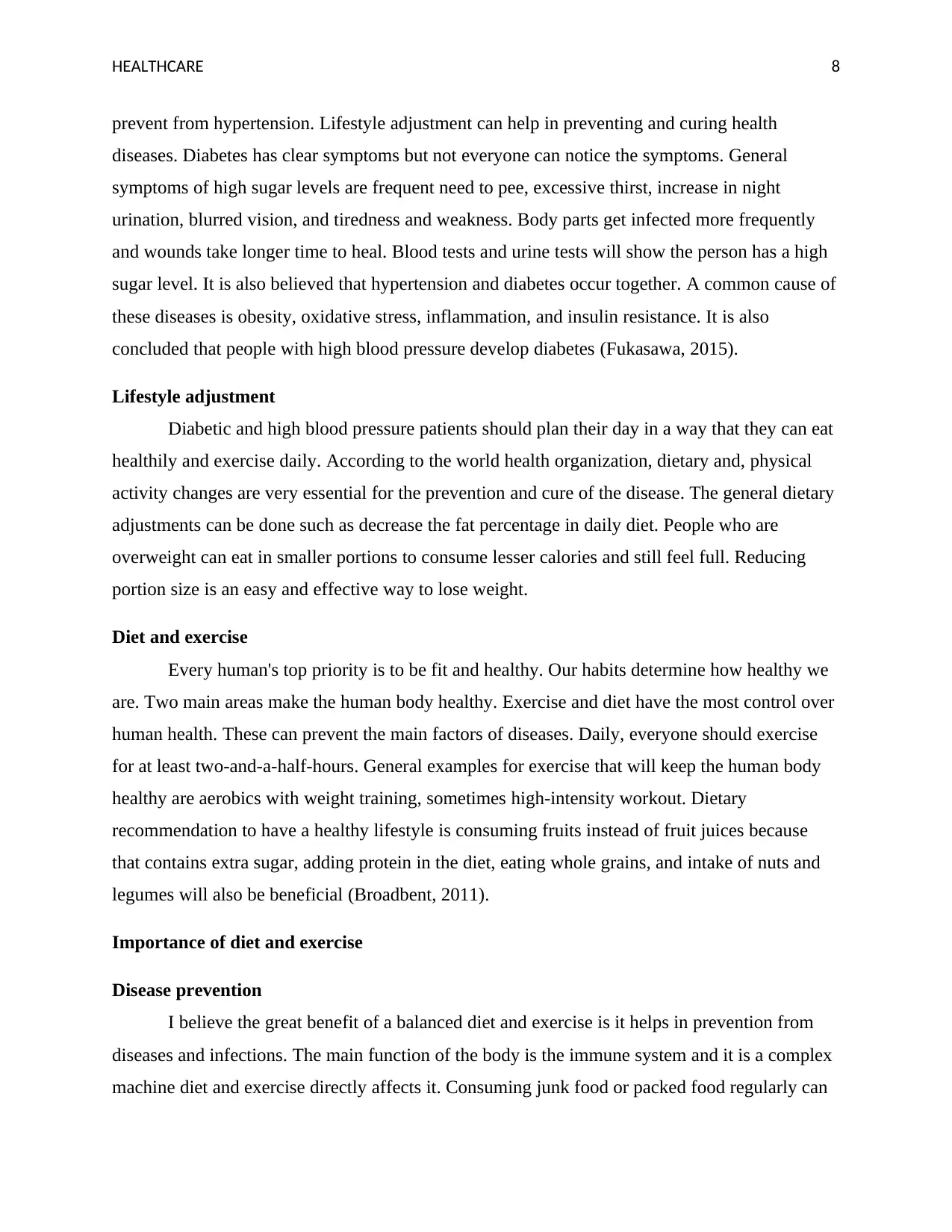
HEALTHCARE 8
prevent from hypertension. Lifestyle adjustment can help in preventing and curing health
diseases. Diabetes has clear symptoms but not everyone can notice the symptoms. General
symptoms of high sugar levels are frequent need to pee, excessive thirst, increase in night
urination, blurred vision, and tiredness and weakness. Body parts get infected more frequently
and wounds take longer time to heal. Blood tests and urine tests will show the person has a high
sugar level. It is also believed that hypertension and diabetes occur together. A common cause of
these diseases is obesity, oxidative stress, inflammation, and insulin resistance. It is also
concluded that people with high blood pressure develop diabetes (Fukasawa, 2015).
Lifestyle adjustment
Diabetic and high blood pressure patients should plan their day in a way that they can eat
healthily and exercise daily. According to the world health organization, dietary and, physical
activity changes are very essential for the prevention and cure of the disease. The general dietary
adjustments can be done such as decrease the fat percentage in daily diet. People who are
overweight can eat in smaller portions to consume lesser calories and still feel full. Reducing
portion size is an easy and effective way to lose weight.
Diet and exercise
Every human's top priority is to be fit and healthy. Our habits determine how healthy we
are. Two main areas make the human body healthy. Exercise and diet have the most control over
human health. These can prevent the main factors of diseases. Daily, everyone should exercise
for at least two-and-a-half-hours. General examples for exercise that will keep the human body
healthy are aerobics with weight training, sometimes high-intensity workout. Dietary
recommendation to have a healthy lifestyle is consuming fruits instead of fruit juices because
that contains extra sugar, adding protein in the diet, eating whole grains, and intake of nuts and
legumes will also be beneficial (Broadbent, 2011).
Importance of diet and exercise
Disease prevention
I believe the great benefit of a balanced diet and exercise is it helps in prevention from
diseases and infections. The main function of the body is the immune system and it is a complex
machine diet and exercise directly affects it. Consuming junk food or packed food regularly can
prevent from hypertension. Lifestyle adjustment can help in preventing and curing health
diseases. Diabetes has clear symptoms but not everyone can notice the symptoms. General
symptoms of high sugar levels are frequent need to pee, excessive thirst, increase in night
urination, blurred vision, and tiredness and weakness. Body parts get infected more frequently
and wounds take longer time to heal. Blood tests and urine tests will show the person has a high
sugar level. It is also believed that hypertension and diabetes occur together. A common cause of
these diseases is obesity, oxidative stress, inflammation, and insulin resistance. It is also
concluded that people with high blood pressure develop diabetes (Fukasawa, 2015).
Lifestyle adjustment
Diabetic and high blood pressure patients should plan their day in a way that they can eat
healthily and exercise daily. According to the world health organization, dietary and, physical
activity changes are very essential for the prevention and cure of the disease. The general dietary
adjustments can be done such as decrease the fat percentage in daily diet. People who are
overweight can eat in smaller portions to consume lesser calories and still feel full. Reducing
portion size is an easy and effective way to lose weight.
Diet and exercise
Every human's top priority is to be fit and healthy. Our habits determine how healthy we
are. Two main areas make the human body healthy. Exercise and diet have the most control over
human health. These can prevent the main factors of diseases. Daily, everyone should exercise
for at least two-and-a-half-hours. General examples for exercise that will keep the human body
healthy are aerobics with weight training, sometimes high-intensity workout. Dietary
recommendation to have a healthy lifestyle is consuming fruits instead of fruit juices because
that contains extra sugar, adding protein in the diet, eating whole grains, and intake of nuts and
legumes will also be beneficial (Broadbent, 2011).
Importance of diet and exercise
Disease prevention
I believe the great benefit of a balanced diet and exercise is it helps in prevention from
diseases and infections. The main function of the body is the immune system and it is a complex
machine diet and exercise directly affects it. Consuming junk food or packed food regularly can
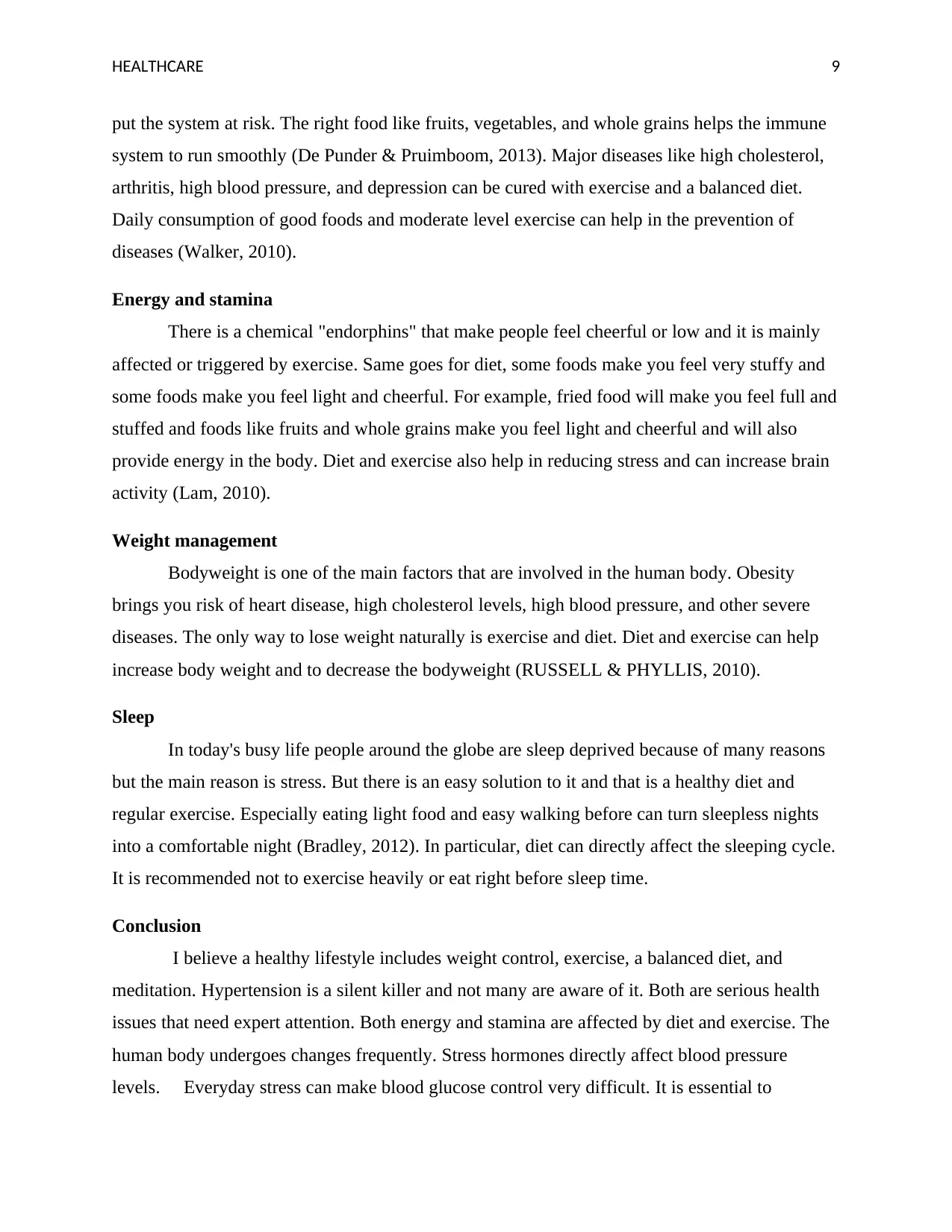
HEALTHCARE 9
put the system at risk. The right food like fruits, vegetables, and whole grains helps the immune
system to run smoothly (De Punder & Pruimboom, 2013). Major diseases like high cholesterol,
arthritis, high blood pressure, and depression can be cured with exercise and a balanced diet.
Daily consumption of good foods and moderate level exercise can help in the prevention of
diseases (Walker, 2010).
Energy and stamina
There is a chemical "endorphins" that make people feel cheerful or low and it is mainly
affected or triggered by exercise. Same goes for diet, some foods make you feel very stuffy and
some foods make you feel light and cheerful. For example, fried food will make you feel full and
stuffed and foods like fruits and whole grains make you feel light and cheerful and will also
provide energy in the body. Diet and exercise also help in reducing stress and can increase brain
activity (Lam, 2010).
Weight management
Bodyweight is one of the main factors that are involved in the human body. Obesity
brings you risk of heart disease, high cholesterol levels, high blood pressure, and other severe
diseases. The only way to lose weight naturally is exercise and diet. Diet and exercise can help
increase body weight and to decrease the bodyweight (RUSSELL & PHYLLIS, 2010).
Sleep
In today's busy life people around the globe are sleep deprived because of many reasons
but the main reason is stress. But there is an easy solution to it and that is a healthy diet and
regular exercise. Especially eating light food and easy walking before can turn sleepless nights
into a comfortable night (Bradley, 2012). In particular, diet can directly affect the sleeping cycle.
It is recommended not to exercise heavily or eat right before sleep time.
Conclusion
I believe a healthy lifestyle includes weight control, exercise, a balanced diet, and
meditation. Hypertension is a silent killer and not many are aware of it. Both are serious health
issues that need expert attention. Both energy and stamina are affected by diet and exercise. The
human body undergoes changes frequently. Stress hormones directly affect blood pressure
levels. Everyday stress can make blood glucose control very difficult. It is essential to
put the system at risk. The right food like fruits, vegetables, and whole grains helps the immune
system to run smoothly (De Punder & Pruimboom, 2013). Major diseases like high cholesterol,
arthritis, high blood pressure, and depression can be cured with exercise and a balanced diet.
Daily consumption of good foods and moderate level exercise can help in the prevention of
diseases (Walker, 2010).
Energy and stamina
There is a chemical "endorphins" that make people feel cheerful or low and it is mainly
affected or triggered by exercise. Same goes for diet, some foods make you feel very stuffy and
some foods make you feel light and cheerful. For example, fried food will make you feel full and
stuffed and foods like fruits and whole grains make you feel light and cheerful and will also
provide energy in the body. Diet and exercise also help in reducing stress and can increase brain
activity (Lam, 2010).
Weight management
Bodyweight is one of the main factors that are involved in the human body. Obesity
brings you risk of heart disease, high cholesterol levels, high blood pressure, and other severe
diseases. The only way to lose weight naturally is exercise and diet. Diet and exercise can help
increase body weight and to decrease the bodyweight (RUSSELL & PHYLLIS, 2010).
Sleep
In today's busy life people around the globe are sleep deprived because of many reasons
but the main reason is stress. But there is an easy solution to it and that is a healthy diet and
regular exercise. Especially eating light food and easy walking before can turn sleepless nights
into a comfortable night (Bradley, 2012). In particular, diet can directly affect the sleeping cycle.
It is recommended not to exercise heavily or eat right before sleep time.
Conclusion
I believe a healthy lifestyle includes weight control, exercise, a balanced diet, and
meditation. Hypertension is a silent killer and not many are aware of it. Both are serious health
issues that need expert attention. Both energy and stamina are affected by diet and exercise. The
human body undergoes changes frequently. Stress hormones directly affect blood pressure
levels. Everyday stress can make blood glucose control very difficult. It is essential to
Secure Best Marks with AI Grader
Need help grading? Try our AI Grader for instant feedback on your assignments.
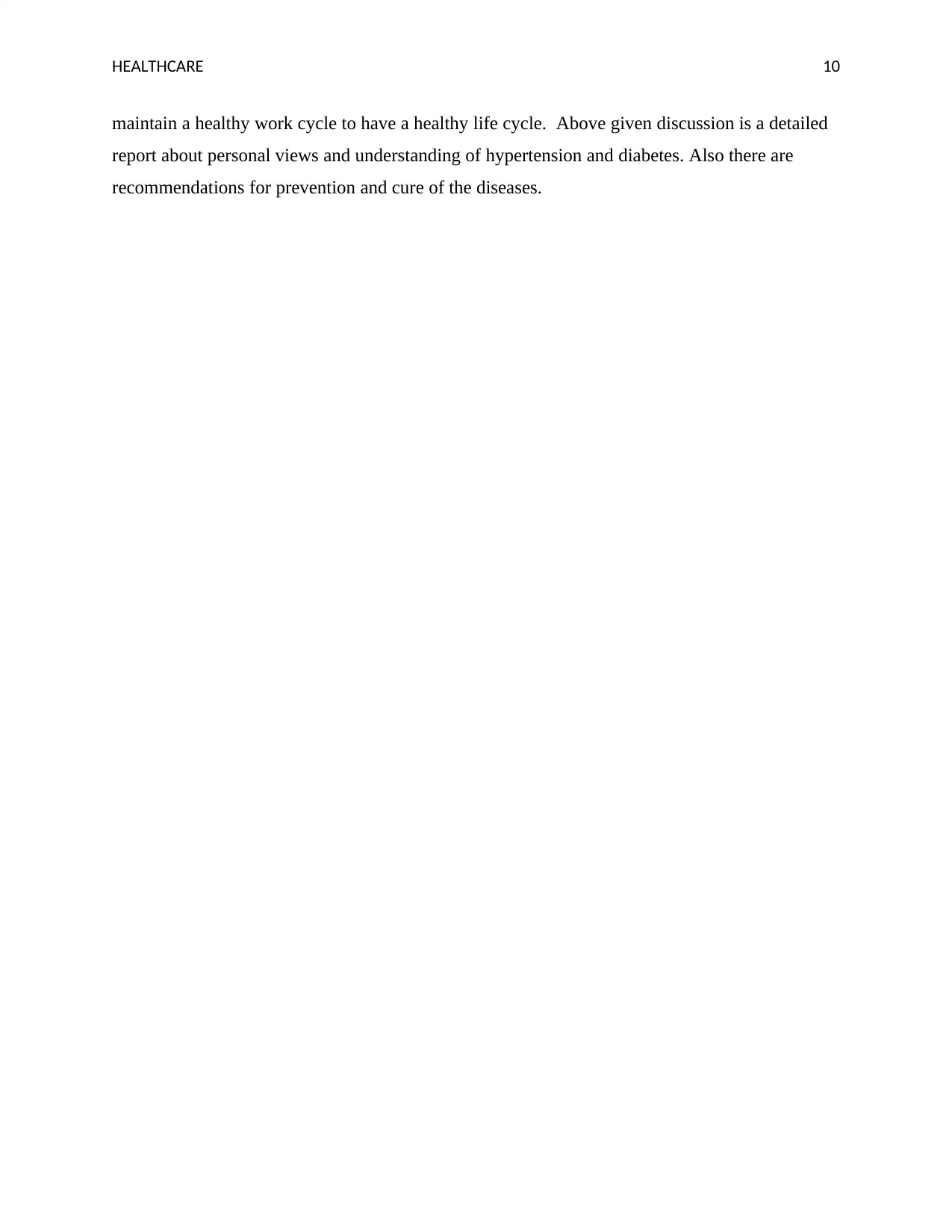
HEALTHCARE 10
maintain a healthy work cycle to have a healthy life cycle. Above given discussion is a detailed
report about personal views and understanding of hypertension and diabetes. Also there are
recommendations for prevention and cure of the diseases.
maintain a healthy work cycle to have a healthy life cycle. Above given discussion is a detailed
report about personal views and understanding of hypertension and diabetes. Also there are
recommendations for prevention and cure of the diseases.
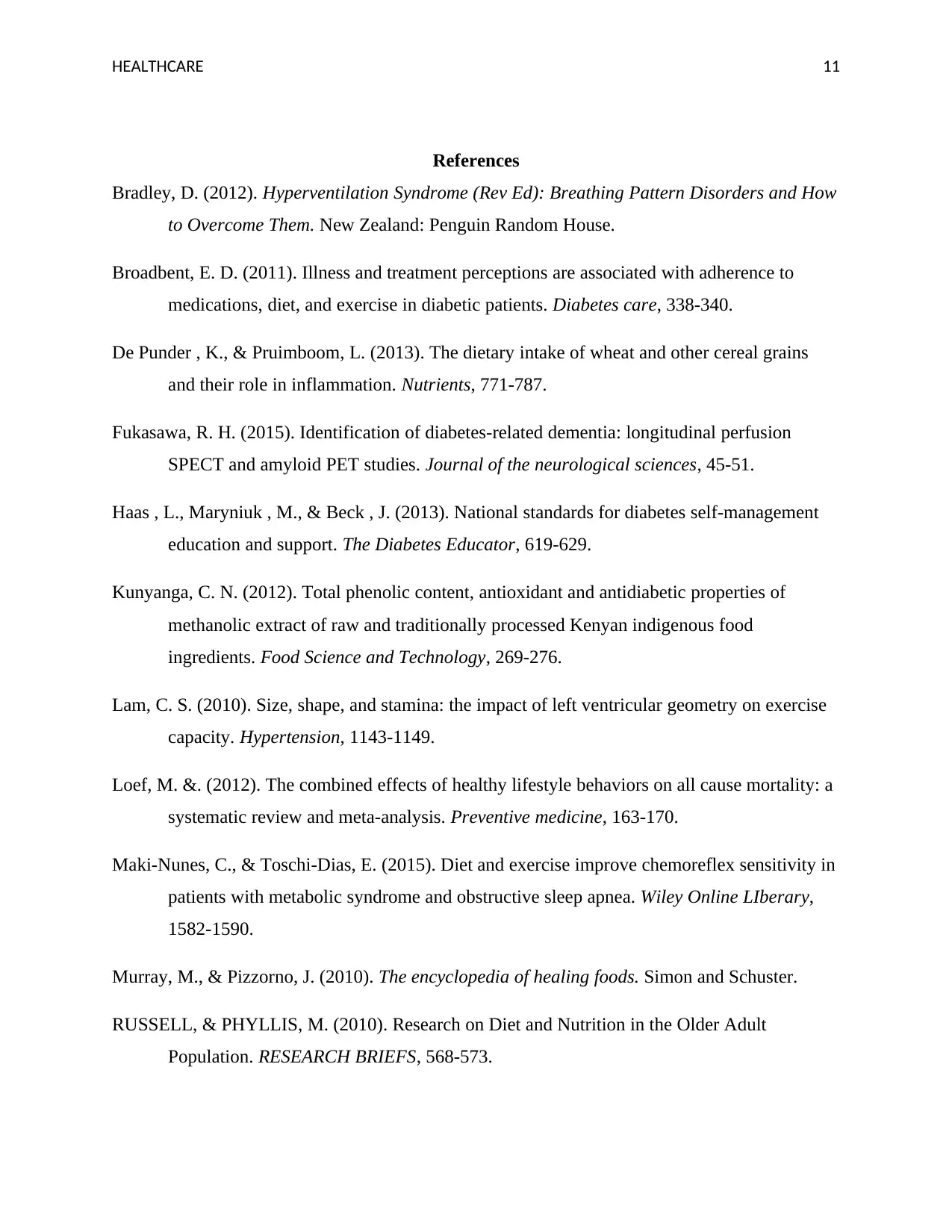
HEALTHCARE 11
References
Bradley, D. (2012). Hyperventilation Syndrome (Rev Ed): Breathing Pattern Disorders and How
to Overcome Them. New Zealand: Penguin Random House.
Broadbent, E. D. (2011). Illness and treatment perceptions are associated with adherence to
medications, diet, and exercise in diabetic patients. Diabetes care, 338-340.
De Punder , K., & Pruimboom, L. (2013). The dietary intake of wheat and other cereal grains
and their role in inflammation. Nutrients, 771-787.
Fukasawa, R. H. (2015). Identification of diabetes-related dementia: longitudinal perfusion
SPECT and amyloid PET studies. Journal of the neurological sciences, 45-51.
Haas , L., Maryniuk , M., & Beck , J. (2013). National standards for diabetes self-management
education and support. The Diabetes Educator, 619-629.
Kunyanga, C. N. (2012). Total phenolic content, antioxidant and antidiabetic properties of
methanolic extract of raw and traditionally processed Kenyan indigenous food
ingredients. Food Science and Technology, 269-276.
Lam, C. S. (2010). Size, shape, and stamina: the impact of left ventricular geometry on exercise
capacity. Hypertension, 1143-1149.
Loef, M. &. (2012). The combined effects of healthy lifestyle behaviors on all cause mortality: a
systematic review and meta-analysis. Preventive medicine, 163-170.
Maki‐Nunes, C., & Toschi‐Dias, E. (2015). Diet and exercise improve chemoreflex sensitivity in
patients with metabolic syndrome and obstructive sleep apnea. Wiley Online LIberary,
1582-1590.
Murray, M., & Pizzorno, J. (2010). The encyclopedia of healing foods. Simon and Schuster.
RUSSELL, & PHYLLIS, M. (2010). Research on Diet and Nutrition in the Older Adult
Population. RESEARCH BRIEFS, 568-573.
References
Bradley, D. (2012). Hyperventilation Syndrome (Rev Ed): Breathing Pattern Disorders and How
to Overcome Them. New Zealand: Penguin Random House.
Broadbent, E. D. (2011). Illness and treatment perceptions are associated with adherence to
medications, diet, and exercise in diabetic patients. Diabetes care, 338-340.
De Punder , K., & Pruimboom, L. (2013). The dietary intake of wheat and other cereal grains
and their role in inflammation. Nutrients, 771-787.
Fukasawa, R. H. (2015). Identification of diabetes-related dementia: longitudinal perfusion
SPECT and amyloid PET studies. Journal of the neurological sciences, 45-51.
Haas , L., Maryniuk , M., & Beck , J. (2013). National standards for diabetes self-management
education and support. The Diabetes Educator, 619-629.
Kunyanga, C. N. (2012). Total phenolic content, antioxidant and antidiabetic properties of
methanolic extract of raw and traditionally processed Kenyan indigenous food
ingredients. Food Science and Technology, 269-276.
Lam, C. S. (2010). Size, shape, and stamina: the impact of left ventricular geometry on exercise
capacity. Hypertension, 1143-1149.
Loef, M. &. (2012). The combined effects of healthy lifestyle behaviors on all cause mortality: a
systematic review and meta-analysis. Preventive medicine, 163-170.
Maki‐Nunes, C., & Toschi‐Dias, E. (2015). Diet and exercise improve chemoreflex sensitivity in
patients with metabolic syndrome and obstructive sleep apnea. Wiley Online LIberary,
1582-1590.
Murray, M., & Pizzorno, J. (2010). The encyclopedia of healing foods. Simon and Schuster.
RUSSELL, & PHYLLIS, M. (2010). Research on Diet and Nutrition in the Older Adult
Population. RESEARCH BRIEFS, 568-573.
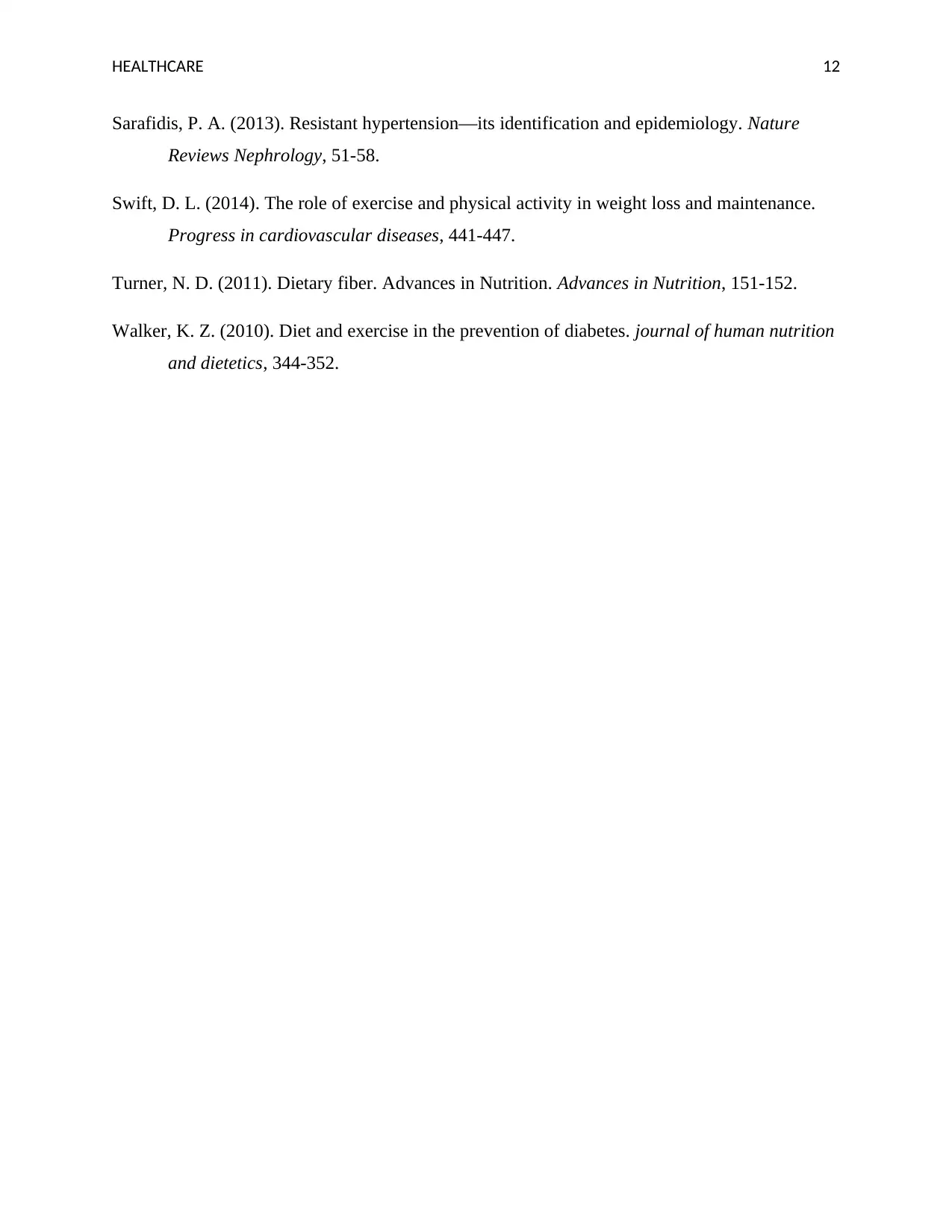
HEALTHCARE 12
Sarafidis, P. A. (2013). Resistant hypertension—its identification and epidemiology. Nature
Reviews Nephrology, 51-58.
Swift, D. L. (2014). The role of exercise and physical activity in weight loss and maintenance.
Progress in cardiovascular diseases, 441-447.
Turner, N. D. (2011). Dietary fiber. Advances in Nutrition. Advances in Nutrition, 151-152.
Walker, K. Z. (2010). Diet and exercise in the prevention of diabetes. journal of human nutrition
and dietetics, 344-352.
Sarafidis, P. A. (2013). Resistant hypertension—its identification and epidemiology. Nature
Reviews Nephrology, 51-58.
Swift, D. L. (2014). The role of exercise and physical activity in weight loss and maintenance.
Progress in cardiovascular diseases, 441-447.
Turner, N. D. (2011). Dietary fiber. Advances in Nutrition. Advances in Nutrition, 151-152.
Walker, K. Z. (2010). Diet and exercise in the prevention of diabetes. journal of human nutrition
and dietetics, 344-352.
1 out of 13
Related Documents
Your All-in-One AI-Powered Toolkit for Academic Success.
+13062052269
info@desklib.com
Available 24*7 on WhatsApp / Email
![[object Object]](/_next/static/media/star-bottom.7253800d.svg)
Unlock your academic potential
© 2024 | Zucol Services PVT LTD | All rights reserved.





